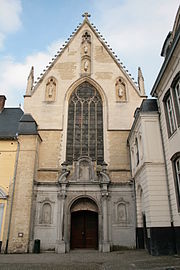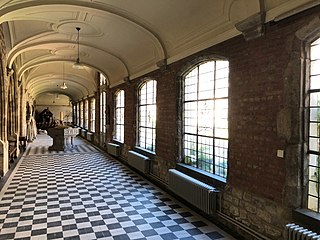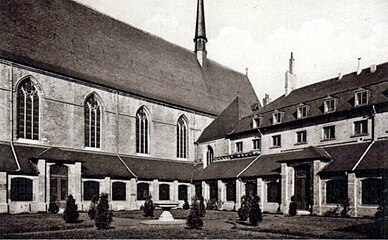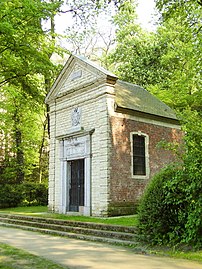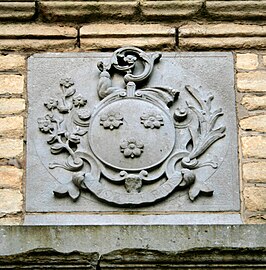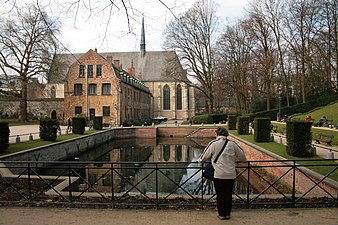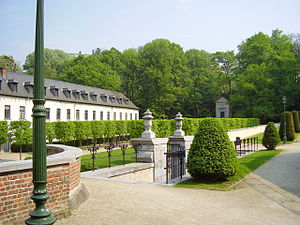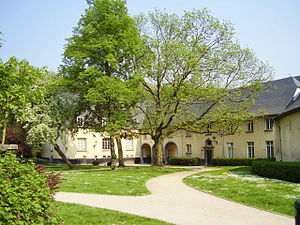La Cambre Abbey
| La Cambre Abbey | |
|---|---|
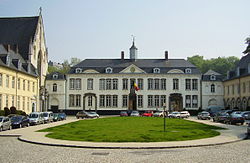 View from thecour d'honneur(main courtyard) | |
 | |
| General information | |
| Type | Abbey |
| Architectural style | |
| Town or city | City of Brussels,Brussels-Capital Region |
| Country | Belgium |
| Coordinates | 50°49′08″N4°22′27″E/ 50.81889°N 4.37417°E |
| Construction started | 1201 |
| Closed | Deconsecrated in 1796 |
| Designations | Protected (30/06/1953) |
| Website | |
| Official website | |
| References | |
| [1] | |
La Cambre Abbey(French:Abbaye de La Cambre,pronounced[a.be.id(ə)lakɑ̃bʁ]) orTer Kameren Abbey(Dutch:Abdij Ter Kameren) is a formerCistercianabbeyin theCity of Brussels,Belgium. It is located in theMaelbeekvalley between theBois de la Cambre/Ter Kamerenbosand theIxelles Ponds.The abbey church is aCatholicparishof theArchdiocese of Mechelen–Brusselsand home to a community ofNorbertinecanons, while other parts of the monastery house the headquarters of theBelgian National Geographic Institute(NGI) andLa Cambre,a prestigiousvisual artsschool.
The abbey was founded around 1196 and reached its apogee in the 13th century. It was suppressed during theFrench Revolutionand abolished in 1796. Most of today's buildings date from the 18th century; only the church, therefectoryand the wing of the capitular hall maintain their medieval character. The simple abbey church housesAlbert Bouts' early 16th-century oil paintingThe Mocking of Christ.
History
[edit]Early history
[edit]The abbey was founded around 1196 by itspatroness Gisèle,anoble lady from Brussels,with the support of themonastic communityofVillers Abbey(in present-dayWalloon Brabant), one of the most importantCisterciancommunities at the time.[a]Duke Henry I of Brabantdonated theIxelles Ponds,awater mill,and the monastery's domain, which remained under the spiritual guidance of Villers. The abbey was namedCamera Beatae Mariae,orAbbaye de la Chambre de Notre-Dame( "Abbey of the Chamber of Our Lady" ), probably in reference to the room inNazarethwhere theVirgin Marylived,[b]which eventually becameLa Cambrein short form.[3][2]

The 13th century was a period of great spiritual influence for La Cambre Abbey: SaintBoniface of Brussels(1182–1260), a native of Ixelles, canon ofCollegiate Church of St. Michael and St. Gudula(future cathedral of Brussels), who taughttheologyat theUniversity of Parisand was made bishop ofLausanne,Switzerland, in 1231, spent the last eighteen years of his life in the abbey and is interred in the church.Saint Alix,a youngleperandmystic,also lived in the community from 1232 until her death in 1249.[4]The 14th century was a difficult period for the abbey: located close to theCity of Brussels,but outsideits wallsand therefore unprotected, it often fell victim to looting. In 1381, a fire caused by looters destroyed most of the buildings. In 1400, the abbey church was built, which still exists today.Gothicin style, it nevertheless retains the mark of Cistercian sobriety.[5]
In the 16th century, some important events took place in the abbey. In 1559,Maximilien de Bergheswas consecrated bishop ofCambrai.On 28 June 1568, it was also there that the widow of theCount of Egmont(with her eleven children) took refuge after the execution of her husband. During the numerouswars of religionof the 16th and 17th centuries, the abbey was once again largely destroyed, namely byCalvinistsin 1581 and again during the French invasions around 1672, but it was rebuilt in the 18th century in the French form it largely retains. In the 17th century, a brewery, mill, barn, pig farm and housing for the servants were built, and in the 18th century, theabbot's house.

Closure and subsequent usage
[edit]La Cambre Abbey was suppressed during theFrench Revolutionand the monastery was closed in 1796, but it escaped complete dismantling. Thelandholdingof 550 hectares (1,400 acres) was sold asnational propertyon 7 April 1797. The buyer was Michel Simons, son of the famous coachbuilder Jean Simons, supplier to the courts and nobility of Europe.[6]After the abbey closed as a monastic community, most of its buildings were demolished; the remaining ones were used successively as amilitary hospitalduring the Revolution, acottonmanufacture for five years, and after being purchased by the (thenNapoleonic) government in 1810, they became apoor house,where the sick, the infirm, thementally insaneand even delinquents were brought together.[7][8]
Between 1874 and 1908, theBelgian Royal Military Academyoccupied the entire site, installing agymnasiumand a games room in the former abbey church. The formercloisterbecame arefectoryand its gallery a courtyard, while the main courtyard became an outdoorriding schooland the terraced garden anexercise ground.[9][10]In 1909, the former abbey church became aparish church,dedicated toSaint Philip Neri.[11]TheBelgian National Geographic Institute(NGI), and before it its predecessors the Military Cartographic Institute and the Military Geographic Institute, occupied the premises of the former abbey palace from 1871 to 2020.[12]
During theFirst World War,the premises wereoccupied by German troops.After their passage, the site was left in ruins. In 1921, under the impetus ofGuillaume Des Marez,archivist for the City of Brussels, and Abbot Maxime-Antoine Carton de Wiart, parish priest of Our Lady of the Cambre and Saint Philip Neri, theLeague of Friends of La Cambremoved into the former abbey to preserve it. The architects Émar Collès and Guillaume-Chrétien Veraart, with the help of Des Marez, were responsible for the restoration. Starting in 1924, the terraced garden and formal clippedbosquetswere restored in the 18th-century manner.[13][14]In 1927, the architectHenry Van de Veldeobtained authorisation to open a Higher Institute of Decorative Arts in the former abbey grounds (today and since 1980 theÉcole nationale supérieure des arts visuels de La Cambre (ENSAV),also simply known as La Cambre, one of the leadingvisual artsand design schools in Belgium).[15][16]The former abbey was designated ahistoric siteon 30 June 1953.[12]
In October 2013, the Premonstratensian canons ofLeffe Abbeyrestored religious life at La Cambre Abbey, at the call of theArchdiocese of Mechelen–Brussels:two canons, established as priory, lead the Christian community there and assumed responsibility for the parish.[17]However, on 1 April 2020, in a joint press release, the Abbot of Leffe and the archdiocese announced the priory's closure by the end of summer.[18]
Architecture and landscape
[edit]Entrances
[edit]On theIxelles Ponds' side, La Cambre Abbey has two entrances, which provide access to the church square, the basin where theMaelbeek streamis born, the terraced gardens, the main courtyard, the abbesses' residence, the abbey church, thecloister,the chapter house, the dormitory, the infirmary and a pavilion. The first entrance is a three-archporticosupported by eight pillars. The other entrance is a monumental 18th-centuryportal,characterised by itsattic.The doorway is arched with bands, flanked by twoDoriccolumns and topped by a broken triangularpediment.The pediment features thecoat of armsof the 41st and last abbess, Séraphine Snoy, which can also be found in many places on the site.
Main courtyard
[edit]Thecour d'honneur(main courtyard), transformed into a car park, is striking for the symmetry and regularity of theneoclassicalbuildings that surround it, including thepresbyteryand the common areas. The main courtyard ends to the north with ahemicycleincluding the entrance door from 1780. While the creation of this courtyard is attributable to the Abbess Louis Delliano y Velasco (1718–1735), it was completed by her successors.[19]
Abbey church
[edit]The Church of Our Lady of the Cambre is located in the south-east corner of the main courtyard. Architecturally, it illustrates the transitional period between the primitiveGothicand theFlamboyant Gothicstyles. The north aisle dates from the 15th century, whilst the south aisle has retained its originalvaultand two early 14th-century windows. It comprises a singlenave54 metres (177 ft) long and 11 metres (36 ft) wide, covered with ashingledvaulterected in 1603 andpolychromedin 1610. The nave is flanked by a rib-vaultedchoirdating from 1657 and lit by five windows, as well as twochapelsforming an asymmetricaltranseptwith similar vaulting.[20]
-
The abbey church's main facade andportal(14th–16th centuries)
-
The centralnave,and on the right, the actual (main) cloister to the south of the church
-
The Mocking of Christ(Bouts,early 16th century)
Cloister
[edit]The cloister is located to the south of the abbey church, as required by Cistercian rule, as well as the refectory, which it adjoins. It was rebuilt in 1599. According to Émile Poumon, it was rebuilt in the second half of the 17th century, and largely rebuilt once more in 1932–1934. The gallery windows featurestained glasswith the coats of arms of the abbesses or of some noble nuns.[21]
-
The cloister's south wall still features 13th-century blind windows and arches.
-
Inside view of the cloister including thebaptismal font
-
The cloister's garden
Abbesses' residence
[edit]The 18th-century abbesses' residence, in the background, is in theLouis XV style.It is divided into three parts: the central part with a triangular pediment preceded by an eight-step staircase, and the two lateral parts, perpendicular wings with carriage entrance and circular pediment. The roof has fourdormer windows.To the right and left, the palace is flanked by a lower, projecting pavilion with a false door on the first floor and two false oval windows on the upper floor. The right pavilion opens onto the rear terraced gardens. On the pavilion's facade, a plaque has been placed in homage to Guillaume Des Marez (1870–1931), one of the leading figures in La Cambre's restoration.[22]
Other buildings
[edit]While the north gallery of the cloister backs onto the church, the east gallery rests on a building that once housed the chapter house, and upstairs, the dormitory. The refectory that supported the south gallery has disappeared. Leaving the church along the dormitory, a second group of 18th-century buildings can be seen further south, including the infirmary (1740 door with coat of arms) and former outbuildings, including the stables. A Louis XV-style pavilion (1760) also stands out.[23]
-
St. Boniface's Chapel
-
Closeup of thecoat of armsof Abbess Séraphine Snoy
Gardens
[edit]TheFrench formal gardenswere created around 1725 by the Abbess Delliano y Velasco, whose coat of arms appears on the wall of the access staircase. They consist of five successiveterraces.They were restored to their original state in 1924. The monumental staircase features two enormous bossed pillars, flanked byvolutesand topped by vases. These gardens have been classified as protected heritage by the Brussels-Capital Region since 30 March 1989.[24]
-
In the garden, there is a basin with one of the sources of theMaelbeek
-
Clipped trees in a formalbosquetform thePromenade des abbesses
-
View of the gardens
-
Another view of the gardens
Residents
[edit]This sectionneeds additional citations forverification.(November 2023) |

Commendatory Abbesses
[edit]- Régine, Lady of Beauffort
- Marie, Lady of Egmont
- Catherine de t'Serclaes
- Catherine Taye
- Marie, Countess vander Noot
- 1627–1709: Isabelle Claire Eugénie Schetz, elected on 6 March 1683, daughter ofAnthonie II Schetz,Count of Grobbendonk
- 1757–1794: Marie Alexandrine Snoy, last abbess, namedDame Séraphine
Bernardine Nuns
[edit]Most of the residing nuns were daughters of importantNoble Housesand the abbesses were usually members of wealthy families. The sisters were namedBernardines of La Cambre.
- SaintAlice of Schaerbeek(1204–1250)
- Constantia Rubens, daughter ofPeter Paul Rubens
- Catherine d'Ittre
See also
[edit]- Roman Catholicism in Belgium
- Neoclassical architecture in Belgium
- History of Brussels
- Culture of Belgium
- Belgium in the long nineteenth century
References
[edit]Footnotes
[edit]- ^The Cistercian order reached its apogee in the early 13th century, not only inBrabant,but also inFlandersand theprincipality of Liège.During theMiddle Ages,some 85 abbeys of Cistercian nuns were founded in the former Netherlands.[2]
- ^In fact, all Cistercian foundations were dedicated to theMother of God.[3]
Citations
[edit]- ^Région de Bruxelles-Capitale (2016)."Abbaye de la Cambre"(in French). Brussels.Retrieved1 November2023.
- ^abMeganck, Marc (2016)."L'abbaye de la Cambre"(PDF).Inventaire du patrimoine architectural de la Région de Bruxelles-Capitale.p. 3.Retrieved1 November2023.
- ^abDemey 2002,p. 6.
- ^Henne & Wauters 1845.
- ^Meganck, Marc (2016)."L'abbaye de la Cambre"(PDF).Inventaire du patrimoine architectural de la Région de Bruxelles-Capitale.p. 11–17.Retrieved1 November2023.
- ^Demey 2002,p. 41.
- ^Demey 2002,p. 42.
- ^Meganck, Marc (2016)."L'abbaye de la Cambre"(PDF).Inventaire du patrimoine architectural de la Région de Bruxelles-Capitale.p. 7.Retrieved1 November2023.
- ^Demey 2002,p. 42–43.
- ^Histoire de l'École militaire: 1834–1934(in French), Brussels, Académie royale de Belgique (Marcel Hayez Printers), 1935, 396 p., in-4° (OCLC 71435352), chap. IV (Les origines de l'École militaire et ses installations successives), p. 108–109
- ^Meganck, Marc (2016)."L'abbaye de la Cambre"(PDF).Inventaire du patrimoine architectural de la Région de Bruxelles-Capitale.p. 13.Retrieved1 November2023.
- ^ab"Ixelles - Abbaye de la Cambre".www.irismonument.be.Retrieved19 August2019.
- ^Demey 2002,p. 46–47.
- ^Meganck, Marc (2016)."L'abbaye de la Cambre"(PDF).Inventaire du patrimoine architectural de la Région de Bruxelles-Capitale.p. 8.Retrieved1 November2023.
- ^Demey 2002,p. 47.
- ^Meganck, Marc (2016)."L'abbaye de la Cambre"(PDF).Inventaire du patrimoine architectural de la Région de Bruxelles-Capitale.p. 32.Retrieved1 November2023.
- ^"Trois moines réinvestissent l'abbaye de la Cambre".RTBF(in French).Retrieved1 November2023.
- ^d'Otreppe, Bosco (31 October 2023)."Les Prémontrés vont quitter l'abbaye de la Cambre à Bruxelles".La Libre.be(in French).Retrieved1 November2023.
- ^Meganck, Marc (2016)."L'abbaye de la Cambre"(PDF).Inventaire du patrimoine architectural de la Région de Bruxelles-Capitale.p. 27–30.Retrieved1 November2023.
- ^Meganck, Marc (2016)."L'abbaye de la Cambre"(PDF).Inventaire du patrimoine architectural de la Région de Bruxelles-Capitale.p. 11–17.Retrieved1 November2023.
- ^Meganck, Marc (2016)."L'abbaye de la Cambre"(PDF).Inventaire du patrimoine architectural de la Région de Bruxelles-Capitale.p. 18–23.Retrieved1 November2023.
- ^Meganck, Marc (2016)."L'abbaye de la Cambre"(PDF).Inventaire du patrimoine architectural de la Région de Bruxelles-Capitale.p. 24–26.Retrieved1 November2023.
- ^Meganck, Marc (2016)."L'abbaye de la Cambre"(PDF).Inventaire du patrimoine architectural de la Région de Bruxelles-Capitale.p. 34–35.Retrieved1 November2023.
- ^Meganck, Marc (2016)."L'abbaye de la Cambre"(PDF).Inventaire du patrimoine architectural de la Région de Bruxelles-Capitale.p. 40–42.Retrieved1 November2023.
Bibliography
[edit]- Demey, Thierry (2002).L'abbaye de la Cambre.Bruxelles, ville d'Art et d'Histoire (in French). Vol. 32. Brussels: Éditions de la Région de Bruxelles-Capitale.
- De Ryckman de Betz, Fernand; Dansaert, Georges; De Maisières, Abbé Thibaut (1948).L'abbaye cistercienne de La Cambre: étude d'histoire et d'archéologie(in French). Brussels: De Nederlandsche Boekhandel.
- Félix, Jean-Pierre (1986).Histoire des orgues de l'abbaye de la Cambre puis paroisse Notre-Dame de la Cambre et Saint Philippe Neri à Ixelles(in French). Brussels: Self-published.
- Hannequart, Jean-Pierre; Schamp, Eric; Pulings, Marie-Claude (1996).Découvrir Bruxelles par ses Espaces Verts(in French). Brussels: Institut bruxellois pour la Gestion de l'Environnement, Commission communautaire française.
- Henne, Alexandre; Wauters, Alphonse (1845).Histoire de la ville de Bruxelles(in French). Vol. 1. Brussels: Périchon. p. 45.
- Maes, André (1981).Histoire de Notre-Dame de la Cambre et de Saint Philippe Néri(in French). Brussels: Self-published.
- Poumon, Émile (1954).Abbayes de Belgique(in French). Brussels: Office de Publicité, S. A., Éditeurs. p. 73.
External links
[edit] Media related toLa Cambre Abbeyat Wikimedia Commons
Media related toLa Cambre Abbeyat Wikimedia Commons

